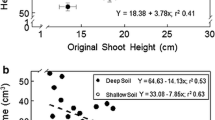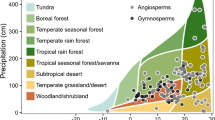Abstract
Present in high concentrations in the heartwood of Larix species, water-soluble arabinogalactans affect the density, moisture content and processing properties of larch wood. The aim of this study was to chart arabinogalactan concentration (AC) and to define the relations between arabinogalactans, and density and shear strength at different axial and radial locations in Larix sibirica Ledeb. trunks. In addition, growth rate (ring width, fibre dimensions) was compared with AC to determine the link between them. Although quite low AC levels were observed, values differed significantly between sapwood and heartwood, with a slight increasing trend from pith to mature heartwood. Variation in growth rate affected AC levels in juvenile wood only. In conclusion, AC levels were clearly lower in the studied cultivated, fast-grown Siberian larches than those measured earlier in trees of natural origin. AC had a weak correlation with growth rate and shear strength.
Zusammenfassung
Wasserlösliche Arabinogalactane, die in hohen Konzentrationen im Kernholz von Lärchen vorhanden sind, haben einen Einfluss auf die Dichte, die Holzfeuchte und die Verarbeitungseigenschaften dieses Holzes. Ziel dieser Studie war es, die Arabinogalactankonzentration (AC) zu ermitteln und die Beziehung zwischen Arabinogalactanen und der Dichte sowie der Scherfestigkeit in verschiedenen axialen und radialen Lagen im Stamm von Larix sibirica Ledeb. zu bestimmen. Darüber hinaus wurde die Wuchsleistung (Jahrringbreite, Faserabmessungen) mit der Arabinogalactankonzentration verglichen, um einen möglichen Zusammenhang aufzuzeigen. Trotz relativ niedriger Arabinogalactankonzentrationen unterschieden sich die Werte von Splint- und Kernholz signifikant, wobei eine leichte Zunahme vom Mark hin zum adulten Kernholz festzustellen war. Unterschiedliche Wachstumsgeschwindigkeiten hatten nur einen Einfluss auf die Arabinogalactankonzentration in juvenilem Holz. Zusammenfassend ist zu sagen, dass die Arabinogalactankonzentration der hier untersuchten, angebauten, schnellwachsenden sibirischen Lärchen eindeutig niedriger war als die der früher untersuchten Lärchen aus natürlichen Beständen. Die Arabinogalactankonzentration korrelierte schwach mit der Wuchsleistung und der Scherfestigkeit.

Similar content being viewed by others
References
Antonova GF, Stasova VV (1997) Effects of environmental factors on wood formation in larch (Larix sibirica Ldb.) stems. Trees 11:462–468
Antonova GF, Chaplykina IA, Varaksina TN, Stasova VV (2005) Ascorbic acid and xylem development in trunks of the Siberian larch trees. Russ J Plant Physiol 52(1):83–92
Bodig J, Jayne BA (1982) Mechanics of wood and wood composites. Van Nostrand Reinhold, New York
Chochieva MM, Antonowsky SD, Nikitin NI (1971) A study on chemical composition and physico-chemical properties of water soluble substances in larch wood. In: Ministry of Pulp and Paper Industry of the USSR (ed) Use of larch as raw material for pulp and paper industry. Ministry of higher and secondary education of the RSFSR. Order of Lenin Kirov Forest—Technical Academy, Leningrad, pp 21–44
Chui YH, MacKinnon-Peters G (1995) Wood properties of exotic larch grown in eastern Canada and north-eastern United States. For Chron 71(5):639–646
Côté WA, Timell TE (1967) Studies on larch arabinogalactan. III. Distribution of arabinogalactan in tamarack. Tappi 50:285–289
Côté WA, Day AC, Simson BW, Timell TE (1966) Studies on larch arabinogalactan. I. The distribution of arabinogalactan in larch wood. Holzforschung 20:178–192
Côté WA, Simson BW, Timell TE (1967) Studies on larch arabinogalactan. II. Degradation of arabinogalactan within the living tree. Holzforschung 21:85–88
Gierlinger N, Wimmer R (2004) Radial distribution of heartwood extractives and lignin in mature European larch. Wood Fiber Sci 36:387–394
Grabner M, Müller U, Gierlinger N, Wimmer R (2005) Effects of heartwood extractives on mechanical properties of larch. IAWA J 26:211–220
Gugnin YA, Perminov ED, Buynitskaya MI, Abakina GM (1971) Sulphate unbleached and bleached larch for board and paper production. In: Ministry of Pulp and Paper Industry of the USSR (ed) Use of larch as raw material for pulp and paper industry. Ministry of higher and secondary education of the RSFSR. Order of Lenin Kirov Forest—Technical Academy, Leningrad, pp 69–82
Hakkila P, Winter A (1973) On the properties of larch wood in Finland. Commun Inst For Fenn 79(7):1–45
Hakkila P, Nikki M, Palenius I (1972) Suitability of larch as pulpwood for Finland. Paperi ja Puu 1972 no. 2: 41–51, 54–55, 57–58
Heikkonen S, Luostarinen K, Piispa K (2007) Kiln drying of Siberian larch (Larix sibirica) timber. Mikkelin ammattikorkeakoulu, A: Tutkimuksia ja raportteja—Research reports 26
Herman M, Dutilleul P, Avella-Shaw T (1998) Intra-ring and inter-ring variations of tracheid length in fast grown versus slow-grown Norway spruces (Picea abies). IAWA J 19:3–23
Khutorschikov ES, Zorina GA (1971) Studies on physical properties and analysis of Siberian larch wood. In: Ministry of Pulp and Paper Industry of the USSR (ed) Use of larch as raw material for pulp and paper industry. Ministry of higher and secondary education of the RSFSR. Order of Lenin Kirov Forest—Technical Academy, Leningrad, pp 3–20
Koizumi A, Takata K, Yamashita K, Nakada R (2003) Anatomical characteristics and mechanical properties of Larix sibirica grown in South-Central Siberia. IAWA J 24:355–370
Koizumi A, Kitagawa M, Hirai T (2005) Effects of growth ring parameters on mechanical properties of Japanese larch (Larix kaempheri) from various provenances. Eurasian J For Res 8:85–90
Korenevsky VF, Nepenin YN (1971) Cooking of far-eastern larch with variable content of water soluble substances in laboratory and industrial conditions. In: Ministry of Pulp and Paper Industry of the USSR (ed) Use of larch as raw material for pulp and paper industry. Ministry of higher and secondary education of the RSFSR. Order of Lenin Kirov Forest—Technical Academy, Leningrad, pp 45–55
Kucera B (1992) Scandinavian standards for testing small defect-free wood samples. Norwegian Forest Research Institute, Department of Forestry, Agricultural University of Norway (In Norwegian), Skogforsk
Luostarinen K (2011a) Density, annual growth and proportions of types of wood of planted fast grown Siberian larch (Larix sibirica) trees. Baltic For 17(1):58–67
Luostarinen K (2011b) Variation in fibre properties of Siberian larch (Larix sibirica Ledeb.) in relation to radial and vertical locations. Ann For Res 68:985–992. doi:10.1007/s13595-011-0106-y
Luostarinen K, Heräjärvi H (2011) Dependence of shear strength on wood properties in cultivated Larix sibirica. Wood Mat Sci Eng 6:177–184
Petrik AW (1968) Comparison of anatomical and pulping properties of some fast-grown trees. Forest Prod J 18(Nov):62
Sairanen P (1982) Properties and usages of larch in the mechanical forest industry in Soviet Union (in Finnish) Metsäntutkimuslaitoksen tiedonantoja 72
Silander V, Lehtonen J, Nikkanen T (2000) Ulkomaisten havupuulajien menestyminen Etelä-Suomessa. Summary: performance of exotic conifers in Southern Finland. Metsäntutkimuslaitoksen tiedonantoja 787
Swenson HA, Kaustinen HM, Bachhuber JJ, Carlson JA (1969) Fractionation and characterization of larchwood arabinogalactan polymers A and B. Macromolecules 2(2):142–145
Taylor AM, Gartner BL, Morrell JJ (2003) Co-incident variations in growth rate and heartwood extractive concentration in Douglas-fir. For Ecol Manage 186:257–260
Terziev N, Zamaratskaia G (2007) Properties and processing of larch timber—a review based on the Soviet and Russian literature. In: Bergstedt A, Lyck C (eds) Larch wood—a literature review. Faculty of Life Sciences, University of Copenhagen, Forest and Landscape Working Papers 23/2007, pp 87-–108. Accessed 2 June 2009. http://www.sl.life.ku.dk/upload/workingpapersno23.pdf
Uprichard JM (1963) The extractive content of New Zealand grown larch species (Larix decidua and Larix leptolepis). Holzforschung 17:129–134
Venäläinen M, Harju AM, Terziev N, Laakso T, Saranpää P (2006) Decay resistance, extractive content, and water sorption capacity of Siberian larch (Larix sibirica Ledeb.) heartwood timber. Holzforschung 60:99–103
Viitanen H, Paajanen L, Saranpää P, Viitaniemi P (1997) Durability of larch (Larix spp.) wood against brown-rot fungi. Document No. IRG/WP 97-10228. International Research. Group on Wood Protection, Stockholm
Vuokila Y (1960) Siperialaisten lehtikuusikoiden kehityksestä ja merkityksestä maamme metsätaloudessa. Summary: on development of Siberian larch stands and their importance to forestry in Finland. Commun Inst For Fenn 52(5):1–111
Willför S, Holmbom B (2004) Isolation and characterization of water soluble polysaccharides from Norway spruce and Scots pine. Wood Sci Technol 38:173–179
Zobel BJ, van Buijtenen JP (1989) Wood variation. Its causes and control. Springer, Berlin
Acknowledgments
Mr. Samuli Heikkonen is thanked for organising the wood material, and Dr. Stefan Willför for advising in laboratory analysis, and Mr. Hannu Koivunen, Mr. Jarmo Pennala, Ms. Merja Essell, Ms. Maini Mononen, and Ms. Leena Kuusisto for preparing the specimens and measuring the AC and shear strength values.
Author information
Authors and Affiliations
Corresponding author
Rights and permissions
About this article
Cite this article
Luostarinen, K., Heräjärvi, H. Relation of arabinogalactans to density, growth rate and shear strength in wood of cultivated Siberian larch. Eur. J. Wood Prod. 71, 29–36 (2013). https://doi.org/10.1007/s00107-012-0651-6
Received:
Published:
Issue Date:
DOI: https://doi.org/10.1007/s00107-012-0651-6




